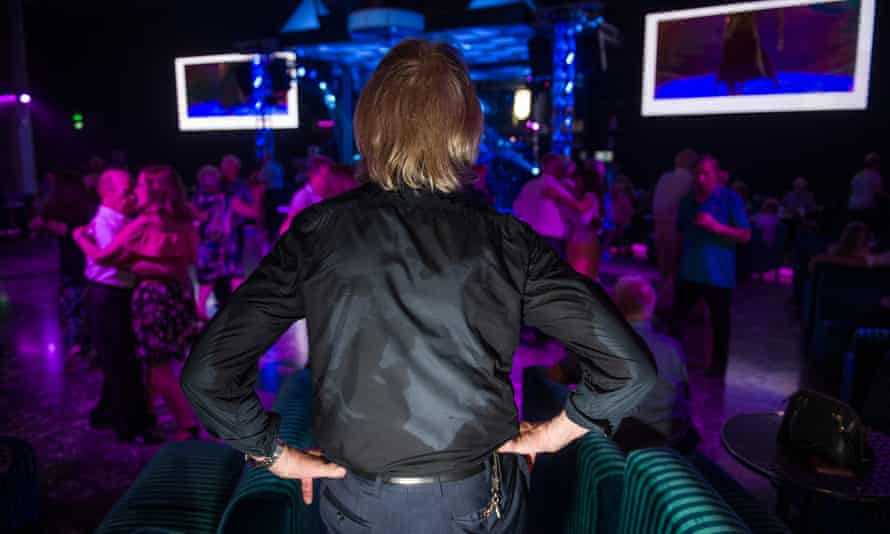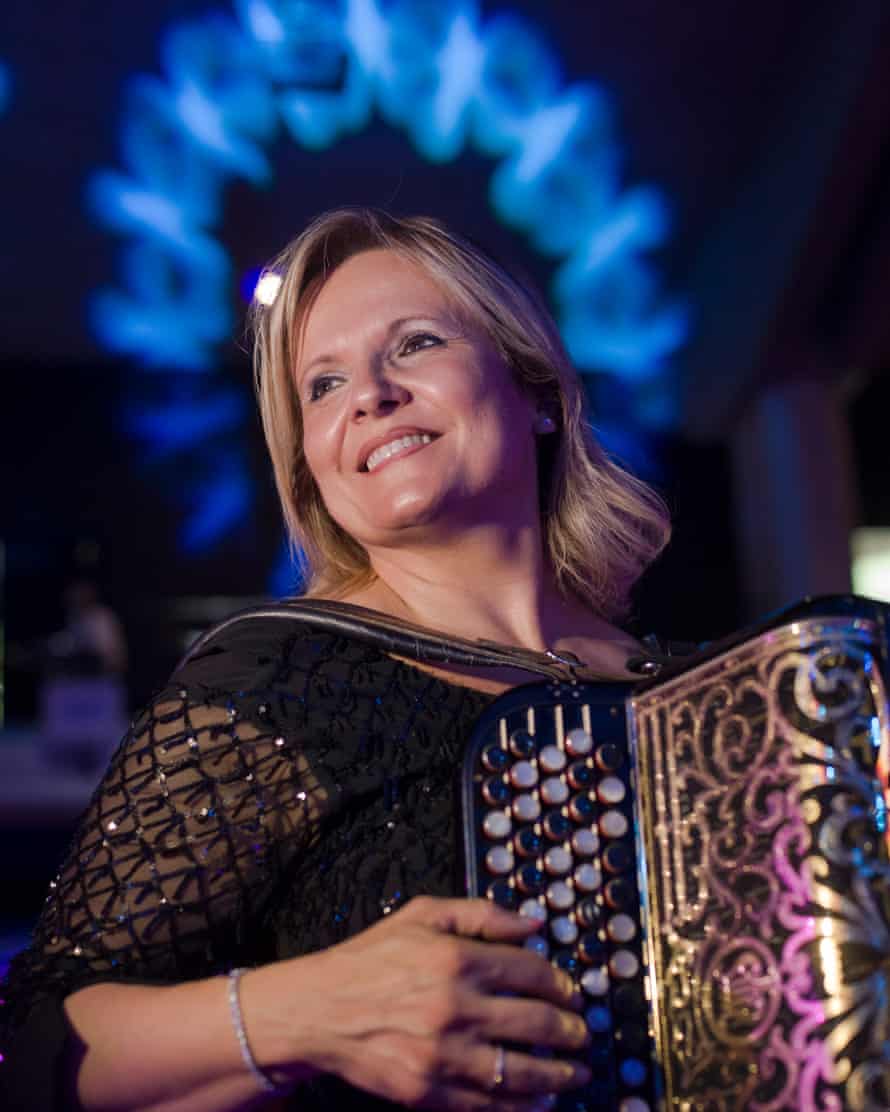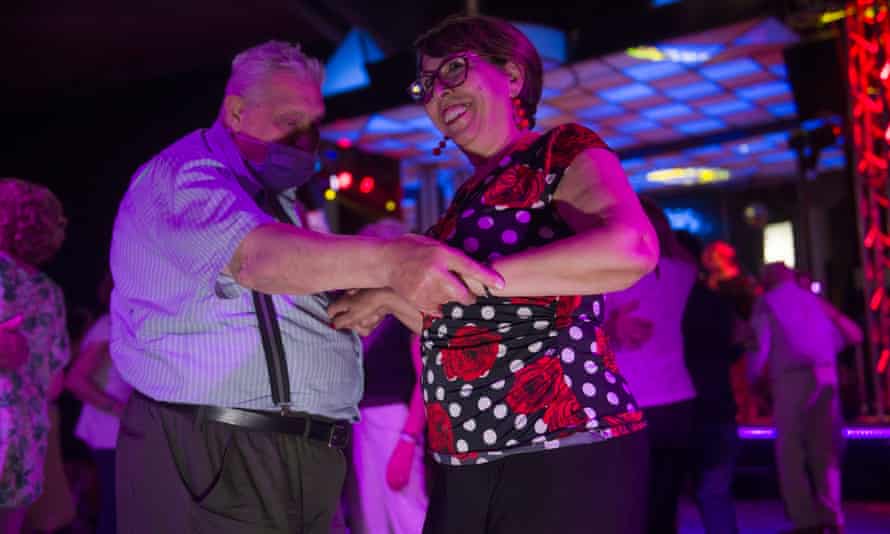Vittorio Piovani is a barber in Traversetolo, a village in central Italy. Every Sunday, he dons an elegant suit, shines his shoes, curls his long moustache and goes dancing at a club in a nearby town, like many other weekend clubbers. Except Piovani is a 75-year-old grandfather of three, living for a scene that gives him a deep-rooted sense of community and belonging.
Piovani is a diehard fan of liscio, an Italian music genre and dancing scene, with dedicated venues called balere, and a fandom that is generally over 50 (more often, over 65). In its own way, it is a glamorous, wild and countercultural corner of European clubbing. The music is effervescent – with a lot of accordion – and the aesthetic is unmistakable: band members wear satin dresses and bell-bottom suits, with lots of shiny fabric and sequins; patrons dress up as if they were attending a wedding. “Liscio has everything: a bit of waltz, a bit of polka, a bit of tango and a bit of slow-dance,” Piovani says inside the club, Redas.
Decades ago, liscio dominated central Italy, especially the region of Emilia-Romagna, but it has gone into a slow decline and now some fear that Covid might have put the final nail in the coffin. Dance halls were closed, on-and-off, for almost two years, before they were allowed to fully reopen when Italy lifted its state of emergency laws this spring. Some of them had shut down for good; others have reopened, but changed genre.
When I visit on a Sunday afternoon, Redas is full and about 150 people are lined up even before the venue is open. “Here we are – for the most part elderly people,” says Ornella, a retired clerk in her 70s. She has been a liscio aficionada since she was young, when the local Communist party organised summer festivals that included liscio dances. Claudia, 69, a cook, comes twice a week, on Thursday evenings and Sundays, because “ballroom dancing is good for my health and takes away my melancholy”.

Many of the people at Redas have a special relationship with the Lucchi-Venturi orchestra, who are playing tonight: “Of course we also hear other orchestras, but this one is special for us, it’s like there’s no distance between musicians and the audience,” says Letizia, who follows the orchestra around Italy with her husband, Massimo. When the band celebrated its 25th anniversary, right before the pandemic, the couple attended a three-day dancing party at a Lake Como hotel.
The orchestra’s namesake and accordionist, Barbara Lucchi, is a celebrity – in the 1980s she was a frequent guest on TV. Together with her husband, Massimo Venturi, also an accordionist, she leads a band of eight members, for the moment cut down to four. In the 1990s, her orchestra was playing 300 concerts each year, which had fallen to about 130 before Covid hit: “It was a complete disaster, during and after the pandemic,” she says. “Liscio artists were hit the worst.”
True, all live music was hit by lockdowns and restrictions, but liscio suffered particularly badly because its audience was more vulnerable to the virus and more cautious about returning. “We had many losses; members of our public have died,” says Lucchi. “Even now, not everyone feels like coming back, and those who do are dancing less often.” Moreover, liscio is about dancing in couples and is incompatible with social distancing.
Liscio, looked down on by Italian mainstream culture because it’s perceived as provincial, low-class and far too camp, has a strongly local and working-class dimension. Its roots are in peasant dancing fairs at the dawn of the 20th century, when Carlo Brighi, a violinist who played with Arturo Toscanini, adapted central European dances, such as the waltz, polka and mazurka, to an Italian taste. But the genre as it is known today was born in the aftermath of the second world war, when violinist and composer Secondo Casadei added modern elements such as saxophone, drums and vocalists, and became a national star. His 1950s hit Romagna mia is still a classic.

Liscio was the only dance native to Italy that survived the import of American genres, such as swing and boogie-woogie, says music critic Giulia Cavaliere. Its success, she explains, was in its romantic appeal: “It’s about dancing and eroticism. The balere were places where women dressed up to attract a companion, and where dance was a precursor to a kiss.” But there’s also an element of class redemption: “For the whole week, you are a farmer or a factory worker, but at the weekend you dress up, and for two days you have a different social role.”
Liscio further boomed in the 1960s and 70s, with orchestras such as Vera Romagna, Vittorio Borghesi, and Castellina e Pasi getting big tours. The star of that era was Raoul Casadei, Secondo’s nephew, who died last year aged 83. Remembered as “il re del Liscio,” Casadei was an icon of the 70s, even beyond the liscio circles, with his concerts aired on TV, and such a powerful household name that other orchestras randomly took the Casadei name to trick the public into believing there was some kind of connection.
But since the 1990s, liscio has suffered a steady, if slow, decline – too distinct to renew itself without losing its aficionados, but perceived as passé by younger Italians. “Back in the day, the clubs were always full and so many orchestras could find good work. Now, a big crowd comes only if big names are playing,” says Venturi. “This used to be a good job, even if you played in a smaller orchestra, but that’s no longer the case.” The economic crisis has prompted some orchestras to cut down on costs, even resorting to karaoke backing tracks, while others simply switch to more profitable genres such as Latin American dance.
“Liscio is becoming lower quality, more repetitive,” laments Moreno Conficconi, a clarinettist, vocalist and arranger who recently founded, with singer Mauro Ferrara and jazz performer Mirco Mariani, a music project called Extraliscio aiming at modernising the style, gleefully contaminating it with punk and electronica.

To liscio fans, Conficconi is a legend: he started to play in 1972 and served as head of orchestra to Raoul Casadei, who gave him the nickname of “il biondo,” by which he still goes today (even if he was never blond). But his fellow Extraliscio crew come from different backgrounds and – given liscio’s low cultural standing – they got some raised eyebrows. Mariani says that, when other jazz musicians learned he was doing a liscio project, “they were so surprised that they thought I must be having some affair with a liscio girl. To them it was just second-class music”.
Extraliscio now enjoy some prestige and have been invited to San Remo, Italy’s most prestigious music festival, but Cavaliere, the critic, doubts that that prestige will extend to the entire genre and says that its decline has deep roots. “Liscio revolved around small communities that gathered in squares and balere, but today young people don’t have that connection to their micro-community – they want to break away from it.”
Conficconi, says that Covid acted “like a guillotine”, to hundreds of orchestras, and when clubs could finally reopen they didn’t get the public that they had hoped for, while Venturi says liscio is going to eventually die: “You don’t find any young person in a balera; the world changes.” But Conficconi says hope is not lost: “It’s a music that brings people together; people have found love dancing liscio. It can’t just disappear.”
Back at Redas Lucchi announces: “Now we’re doing the polka challenge!” The crowd erupts in cheers: they dance, chat and drink for hours, still having the time of their lives.
Stay connected with us on social media platform for instant update click here to join our Twitter, & Facebook
We are now on Telegram. Click here to join our channel (@TechiUpdate) and stay updated with the latest Technology headlines.
For all the latest Music News Click Here
